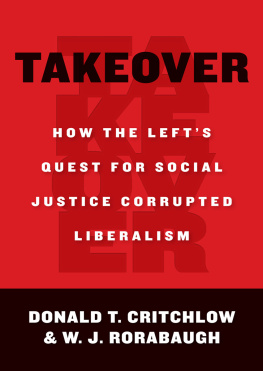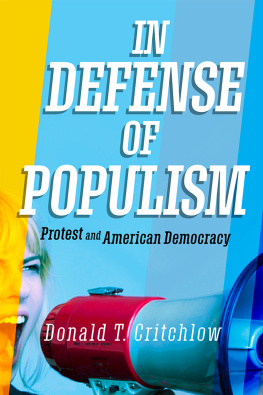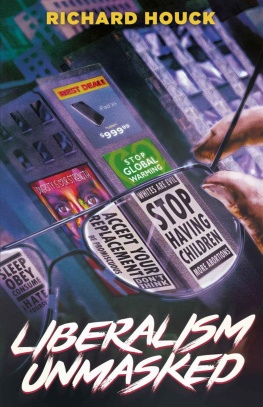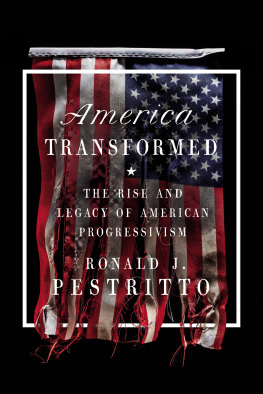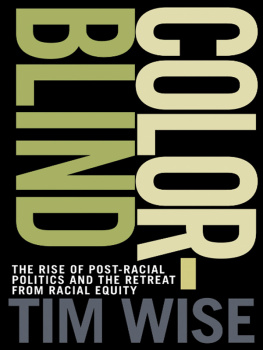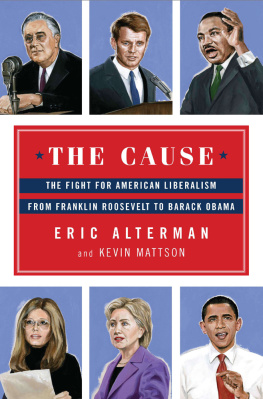Introduction
The New Progressives
H ow did liberals get to be the way they are today?
This book answers that important question. It is a question more and more Americans began asking as they witnessed the ascent of Barack Obama, the most left-wing Democrat to be nominated for president since George McGovern in 1972 and arguably the most progressive president ever elected.
Searching for answers, many commentators have looked back to the progressive movement of the early twentieth century. To observers such as talk radio host Glenn Beck, author Jonah Goldberg, and historian Ronald J. Pestritto, modern liberalism is of a piece with the progressivism that President Woodrow Wilson embodied a century ago. To be sure, todays liberals, many of whom embrace the label progressive, share the older progressive faith in using governmental power to address societal ills. But this focus on the similarities between modern liberalism and early-twentieth-century progressivism overlooks a sharp break in the history of liberalism that began in the 1960s. Only by understanding that breakand the radicalism that accompanied itcan we fully understand our current political situation.
The older progressive tradition primarily aimed to address the ills of industrial capitalism. Progressive reformers such as Theodore Roosevelt and Woodrow Wilson sought strict regulations on business to protect the rights and health of workers and citizens and to deal with the problem of corporate monopoly. They proposed an associative order in which civic and business organizations cooperated with government at the municipal, state, and federal levels to promote the general welfare. In the 1930s, Franklin Roosevelts New Deal built on this reform tradition by providing a safety netold-age pensions, unemployment benefits, and welfare payments. Lyndon Johnsons Great Society went further in the 1960s, extending grants and loans to college students, establishing the Jobs Corps, creating Medicare and Medicaid, and declaring war on poverty. But this progressive tradition did not seek to dismantle capitalism itself. Even the New Deal, for all its statist sympathies, refused to nationalize banks or ailing industries during the worst global economic crisis in history.
The liberal agenda today is much more radical and encompassing. It is no coincidence that upon taking office, President Obama pushed for government control of nearly every aspect of American lifethrough nationalized health care, environmental regulation, caps on energy use, financial regulation, and a range of other governmental intrusions. The roots of this radicalism lie in a strategy that emerged in the 1960s and 1970s to challenge the American corporate order.
Infiltrating the Establishment
The New Left that came of age in the 1960s was not an extension of Roosevelt-Wilson progressive reform. Nor, for that matter, was it a continuation of New Deal or Great Society liberalism. Indeed, these activists denounced mainstream liberalism as the enemy of reform. Influenced by a rekindled interest in Marx, they saw the New Deal regulatory state as benefiting large corporations, and the New Deal welfare state as only an ameliorative measure designed to maintain class privilege. Where earlier progressives were concerned mostly with the failings of industrial capitalism, the new activists of the 1960s addressed the problems of a postindustrial order, which were related more to affluence than to scarcity. The range of concerns thus expanded beyond poverty and inequality to include corporate greed, toxic waste, unsafe consumer products, environmental abuse, overpopulation, and many other issues. These radicals disparaged consumption and corporate capitalism. They espoused what they called community control and direct democracy, though leaders of this movement generally came from elite backgrounds and aimed to impose their visions of social justice on the rest of society. This emergent Left was a new political phenomenon.
By the early 1970s, the New Lefts antiVietnam War protests and other street activism had faded away. But the radicalism remained. The activists simply changed their tactics for remaking American society. After fighting against the establishment, radical leaders discovered that they could achieve much more by working within the system. They learned to harness politics and the courts to pursue what they thought of as social justice. Becoming lawyers, professors, journalists, consumer advocates, union leaders, and even politicians, left-wing activists morphed into a new movementthe New Progressives.
This book examines how the New Progressives colonized many areas of American life in creative and powerful ways. They achieved their two most significant successes in rewriting the Democratic Partys presidential nominating rules and in remaking the legal profession. In the first case, New Progressive activists got their opportunity following the disastrous 1968 Democratic National Convention. Antiwar activists were outraged that Vice President Hubert Humphrey had won the Democratic nomination despite earning a small percentage of primary votes. The Democratic Party responded by appointing a commission, headed by antiwar senator George McGovern, to revise the partys process for selecting delegates. Reformers on the commissionespecially young staffers who came out of the antiwar movementquietly rewrote the rules to give much greater power to left-wing activists, including peace protesters, feminists, environmentalists, community organizers, homosexual-rights advocates, and ethnic-minority leaders. These rules changes have had long-term consequences for the Democratic Party, enshrining identity politics and pushing the party much further to the left. As this book will show, Barack Obama almost certainly could not have won the 2008 Democratic presidential nomination without the McGovern Commissions changes favoring progressive activists.
Still, New Progressives maintained an uneasy alliance with the Democratic Party. Left-wing activists wanted to radically transform American societyby pursuing militant environmentalism; tearing down corporate power; crusading for population control, abortion, and euthanasia; pushing for nationalized health insurance; and more. But electoral politics meant compromise, working with lobbying interests, and trusting politicians interested only in winning elections. Often, too, New Progressives found that voters did not embrace their radical agenda. They needed to find a way to impose their vision on the country. That is where the second notable achievement, in the field of law, proved so consequential.
New Progressive legal activists practically invented the field of public interest law. Growing out of the rights revolution of the 1960s and especially the anticorporate crusading of Ralph Nader, a left-wing legal movement took advantage of liability law and class-action suits to go after businesses, physicians, civic organizations, government agencies, and any number of other groups. By the mid-1970s, leading New Progressive legal thinkers had laid out the strategy for taking down corporations in the name of giving power to the people. One prescient essay outlined how class-action suits could be used to exact hundreds of billions of dollars from tobacco and liquor companies, the pharmaceutical industry, food manufacturers, and other groupsexactly what activist lawyers would do in the succeeding decades.

